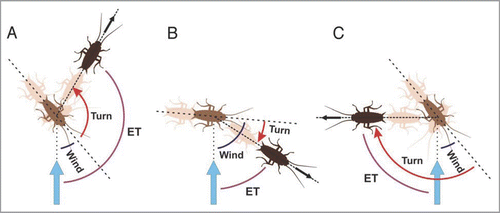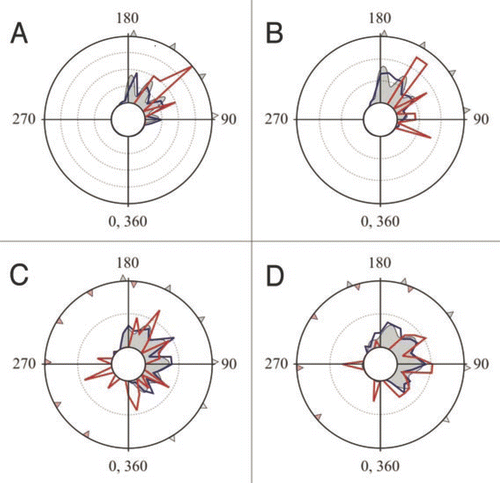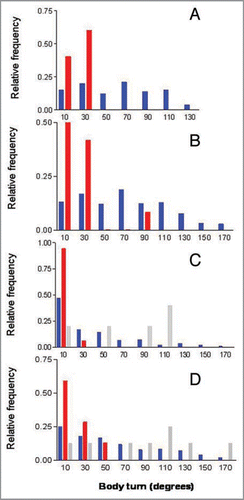Figures & data
Figure 1 Cockroaches respond to a wind stimulus (vertical blue arrow) with either away (A), towards (B) or overshooting towards responses (C). In away responses (A), cockroaches rotate their body in a direction opposite to the stimulus. The final direction of motion (black arrow) is along an ET (purple curve) which corresponds to the sum of wind angle (blue curve) and turn angle (red curved arrow). In towards responses (B), cockroaches rotate their body in the direction of the stimulus. The resulting ET corresponds to wind angle minus turn angle. In overshooting towards responses (C), after an initial rotation towards the stimulus, cockroaches continue the rotation in a direction away from the stimulus. As in other towards responses, the resulting ET is calculated as wind angle minus turn angle, i.e., in this case 45° − 135° = −90°, which in our previous circular statistical analysis1 would correspond to an ET of 270°.

Figure 2 Though far less frequent, toward responses show similar ET peaks to away responses. Circular frequency distribution polygons of ETs in the four data sets analyzed in Domenici et al. (2008).Citation1 (A) singletons, (B) data-set 5i, (C) data from Camhi and Tom (1978),Citation9 (D) data from Comer and Dowd (1987).Citation10 Frequency values (shown as concentric circles of 0.1 each) are relative proportions of away responses (blue lines), towards responses (red lines), and the multimodal curves fitted for all the data in Domenici et al. (2008)Citation1 (grey-filled areas). Note that the away and towards ET peaks are in similar positions. Towards responses >180° are overshooting responses and are only seen in the data sets comprising (C and D). Red triangles in the 180−360° sector indicate mirror images of the peaks (grey triangles) found in the 0−180° sector for the distributions of away responses. Note that these overshooting ET peaks are approximately positioned at the mirror image of opposite away peaks.

Figure 3 Body-turn angles have different distributions for away and towards responses. Frequency distribution of body-turn angles in the four data sets analyzed in Domenici et al. (2008).Citation1 The centre of each 20° bin is indicated on the x-axis. (A) singletons, (B) data-set 5i, (C) data from Camhi and Tom (1978),Citation9 (D) data from Comer and Dowd (1987).Citation10 Frequency values are relative proportions of away responses (blue bars), non-overshooting towards responses (red bars) and overshooting towards responses (grey bars).
